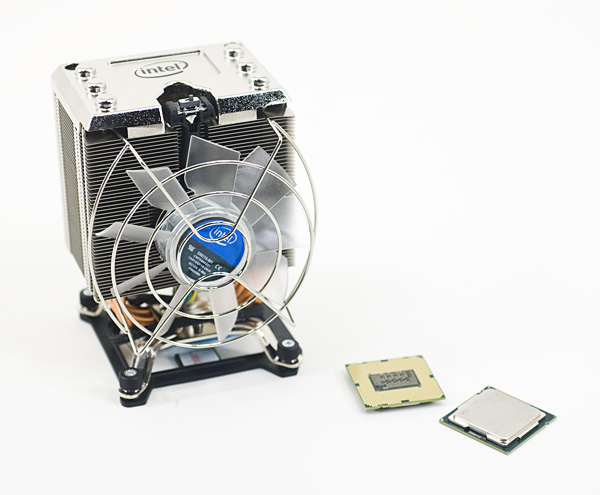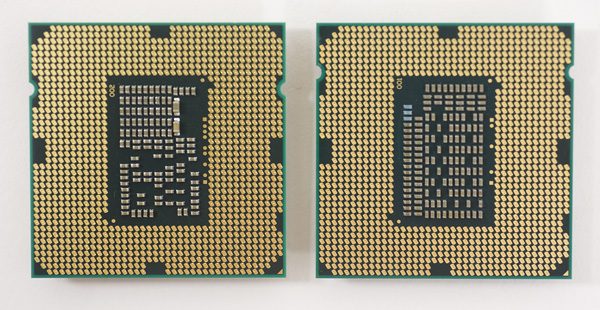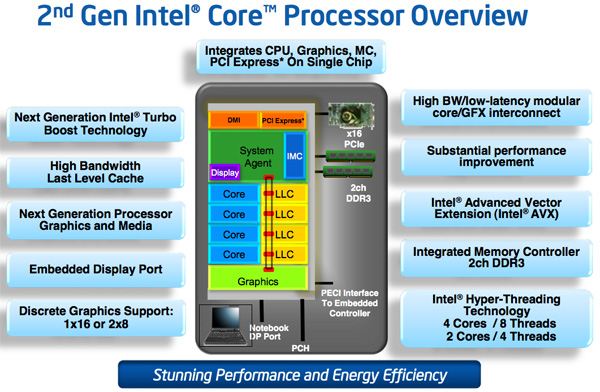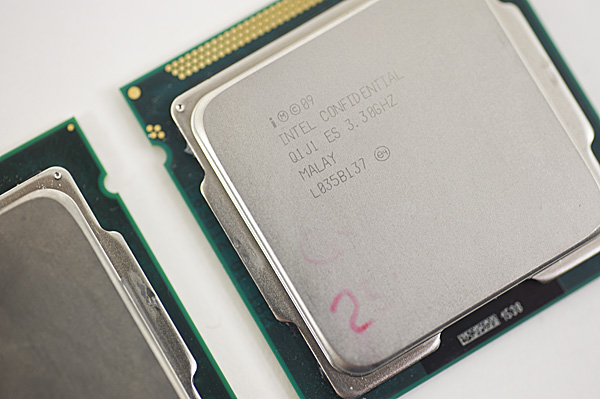The Sandy Bridge Review: Intel Core i7-2600K, i5-2500K and Core i3-2100 Tested
by Anand Lal Shimpi on January 3, 2011 12:01 AM ESTIntel never quite reached 4GHz with the Pentium 4. Despite being on a dedicated quest for gigahertz the company stopped short and the best we ever got was 3.8GHz. Within a year the clock (no pun intended) was reset and we were all running Core 2 Duos at under 3GHz. With each subsequent generation Intel inched those clock speeds higher, but preferred to gain performance through efficiency rather than frequency.
Today, Intel quietly finishes what it started nearly a decade ago. When running a single threaded application, the Core i7-2600K will power gate three of its four cores and turbo the fourth core as high as 3.8GHz. Even with two cores active, the 32nm chip can run them both up to 3.7GHz. The only thing keeping us from 4GHz is a lack of competition to be honest. Relying on single-click motherboard auto-overclocking alone, the 2600K is easily at 4.4GHz. For those of you who want more, 4.6-4.8GHz is within reason. All on air, without any exotic cooling.
Unlike Lynnfield, Sandy Bridge isn’t just about turbo (although Sandy Bridge’s turbo modes are quite awesome). Architecturally it’s the biggest change we’ve seen since Conroe, although looking at a high level block diagram you wouldn’t be able to tell. Architecture width hasn’t changed, but internally SNB features a complete redesign of the Out of Order execution engine, a more efficient front end (courtesy of the decoded µop cache) and a very high bandwidth ring bus. The L3 cache is also lower and the memory controller is much faster. I’ve gone through the architectural improvements in detail here. The end result is better performance all around. For the same money as you would’ve spent last year, you can expect anywhere from 10-50% more performance in existing applications and games from Sandy Bridge.
I mentioned Lynnfield because the performance mainstream quad-core segment hasn’t seen an update from Intel since its introduction in 2009. Sandy Bridge is here to fix that. The architecture will be available, at least initially, in both dual and quad-core flavors for mobile and desktop (our full look at mobile Sandy Bridge is here). By the end of the year we’ll have a six core version as well for the high-end desktop market, not to mention countless Xeon branded SKUs for servers.
The quad-core desktop Sandy Bridge die clocks in at 995 million transistors. We’ll have to wait for Ivy Bridge to break a billion in the mainstream. Encompassed within that transistor count are 114 million transistors dedicated to what Intel now calls Processor Graphics. Internally it’s referred to as the Gen 6.0 Processor Graphics Controller or GT for short. This is a DX10 graphics core that shares little in common with its predecessor. Like the SNB CPU architecture, the GT core architecture has been revamped and optimized to increase IPC. As we mentioned in our Sandy Bridge Preview article, Intel’s new integrated graphics is enough to make $40-$50 discrete GPUs redundant. For the first time since the i740, Intel is taking 3D graphics performance seriously.
| CPU Specification Comparison | ||||||||
| CPU | Manufacturing Process | Cores | Transistor Count | Die Size | ||||
| AMD Thuban 6C | 45nm | 6 | 904M | 346mm2 | ||||
| AMD Deneb 4C | 45nm | 4 | 758M | 258mm2 | ||||
| Intel Gulftown 6C | 32nm | 6 | 1.17B | 240mm2 | ||||
| Intel Nehalem/Bloomfield 4C | 45nm | 4 | 731M | 263mm2 | ||||
| Intel Sandy Bridge 4C | 32nm | 4 | 995M | 216mm2 | ||||
| Intel Lynnfield 4C | 45nm | 4 | 774M | 296mm2 | ||||
| Intel Clarkdale 2C | 32nm | 2 | 384M | 81mm2 | ||||
| Intel Sandy Bridge 2C (GT1) | 32nm | 2 | 504M | 131mm2 | ||||
| Intel Sandy Bridge 2C (GT2) | 32nm | 2 | 624M | 149mm2 | ||||
It’s not all about hardware either. Game testing and driver validation actually has real money behind it at Intel. We’ll see how this progresses over time, but graphics at Intel today very different than it has ever been.
Despite the heavy spending on an on-die GPU, the focus of Sandy Bridge is still improving CPU performance: each core requires 55 million transistors. A complete quad-core Sandy Bridge die measures 216mm2, only 2mm2 larger than the old Core 2 Quad 9000 series (but much, much faster).
As a concession to advancements in GPU computing rather than build SNB’s GPU into a general purpose compute monster Intel outfitted the chip with a small amount of fixed function hardware to enable hardware video transcoding. The marketing folks at Intel call this Quick Sync technology. And for the first time I’ll say that the marketing name doesn’t do the technology justice: Quick Sync puts all previous attempts at GPU accelerated video transcoding to shame. It’s that fast.
There’s also the overclocking controversy. Sandy Bridge is all about integration and thus the clock generator has been moved off of the motherboard and on to the chipset, where its frequency is almost completely locked. BCLK overclocking is dead. Thankfully for some of the chips we care about, Intel will offer fully unlocked versions for the enthusiast community. And these are likely the ones you’ll want to buy. Here’s a preview of what’s to come:
The lower end chips are fully locked. We had difficulty recommending most of the Clarkdale lineup and I wouldn’t be surprised if we have that same problem going forward at the very low-end of the SNB family. AMD will be free to compete for marketshare down there just as it is today.
With the CPU comes a new platform as well. In order to maintain its healthy profit margins Intel breaks backwards compatibility (and thus avoids validation) with existing LGA-1156 motherboards, Sandy Bridge requires a new LGA-1155 motherboard equipped with a 6-series chipset. You can re-use your old heatsinks however.

Clarkdale (left) vs. Sandy Bridge (right)
The new chipset brings 6Gbps SATA support (2 ports) but still no native USB 3.0. That’ll be a 2012 thing it seems.













283 Comments
View All Comments
DanNeely - Monday, January 3, 2011 - link
The increased power efficiency might allow Apple to squeeze a GPU onto their smaller laptop boards without loosing runtime due to the smaller battery.yuhong - Monday, January 3, 2011 - link
"Unlike P55, you can set your SATA controller to compatible/legacy IDE mode. This is something you could do on X58 but not on P55. It’s useful for running HDDERASE to secure erase your SSD for example"Or running old OSes.
DominionSeraph - Monday, January 3, 2011 - link
"taking the original Casino Royale Blu-ray, stripping it of its DRM"Whoa, that's illegal.
RussianSensation - Monday, January 3, 2011 - link
It would have been nice to include 1st generation Core i7 processors such as 860/870/920-975 in Starcraft 2 bench as it seems to be very CPU intensive.Also, perhaps a section with overclocking which shows us how far 2500k/2600k can go on air cooling with safe voltage limits (say 1.35V) would have been much appreciated.
Hrel - Monday, January 3, 2011 - link
Sounds like this is SO high end it should be the server market. I mean, why make yet ANOTHER socket for servers that use basically the same CPU's? Everything's converging and I'd just really like to see server mobo's converge into "High End Desktop" mobo's. I mean seriously, my E8400 OC'd with a GTX460 is more power than I need. A quad would help with the video editing I do in HD but it works fine now, and with GPU accelerated rendering the rendering times are totally reasonable. I just can't imagine anyone NEEDING a home computer more powerful than the LGS-1155 socket can provide. Hell, 80-90% of people are probably fine with the power Sandy Bridge gives in laptops now.mtoma - Monday, January 3, 2011 - link
Perhaps it is like you say, however it's always good for buyers to decide if they want server-like features in a PC. I don't like manufacturers to dictate to me only one way to do it (like Intel does now with the odd combination of HD3000 graphics - Intel H67 chipset). Let us not forget that for a long time, all we had were 4 slots for RAM and 4-6 SATA connections (like you probably have). Intel X58 changed all that: suddenly we had the option of having 6 slots for RAM, 6-8 SATA connections and enough PCI-Express lanes.I only hope that LGA 2011 brings back those features, because like you said: it's not only the performance we need, but also the features.
And, remeber that the software doesn't stay still, it usualy requires multiple processor cores (video transcoding, antivirus scanning, HDD defragmenting, modern OS, and so on...).
All this aside, the main issue remains: Intel pus be persuaded to stop luting user's money and implement only one socket at a time. I usually support Intel, but in this regard, AMD deserves congratulations!
DanNeely - Monday, January 3, 2011 - link
LGA 2011 is a high end desktop/server convergence socket. Intel started doing this in 2008, with all but the highest end server parts sharing LGA1366 with top end desktop systems. The exception was quad/octo socket CPUs, and those using enormous amounts of ram using LGA 1567.The main reason why LGA 1155 isn't suitable for really high end machines is that it doesn't have the memory bandwidth to feed hex and octo core CPUs. It's also limited to 16 PCIe 2.0 lanes on the CPU vs 36 PCIe 3.0 lanes on LGA2011. For most consumer systems that won't matter, but 3/4 GPU card systems will start loosing a bit of performance when running in a 4x slot (only a few percent, but people who spend $1000-2000 on GPUs want every last frame they can get), high end servers with multiple 10GB ethernet cards and PCIe SSD devices also begin running into bottlenecks.
Not spending an extra dollar or five per system for the QPI connections only used in multi-socket systems in 1155 also adds up to major savings across the hundreds of millions of systems Intel is planning to sell.
Hrel - Monday, January 3, 2011 - link
I'm confused by the upset over playing video at 23.967hz. "It makes movies look like, well, movies instead of tv shows"? What? Wouldn't recording at a lower frame rate just mean there's missed detail especially in fast action scenes? Isn't that why HD runs at 60fps instead of 30fps? Isn't more FPS good as long as it's played back at the appropriate speed? IE whatever it's filmed at? I don't understand the complaint.On a related note hollywood and the world need to just agree that everything gets recorded and played back at 60fps at 1920x1080. No variation AT ALL! That way everything would just work. Or better yet 120FPS and with the ability to turn 3D on and off as u see fit. Whatever FPS is best. I've always been told higher is better.
chokran - Monday, January 3, 2011 - link
You are right about having more detail when filming with higher FPS, but this isn't about it being good or bad, it's more a matter of tradition and visual style.The look movies have these days, the one we got accustomed to, is mainly achieved by filming it in 24p or 23.967 to be precise. The look you get when filming with higher FPS just doesn't look like cinema anymore but tv. At least to me. A good article on this:
http://www.videopia.org/index.php/read/shorts-main...
The problem with movies looking like TV can be tested at home if you got a TV that has some kind of Motion Interpolation, eg. MotionFlow called by Sony or Intelligent Frame Creation by Panasonic. When turned on, you can see the soap opera effect by adding frames. There are people that don't see it and some that do and like it, but I have to turn it of since it doesn't look "natural" to me.
CyberAngel - Thursday, January 6, 2011 - link
http://en.wikipedia.org/wiki/Showscan